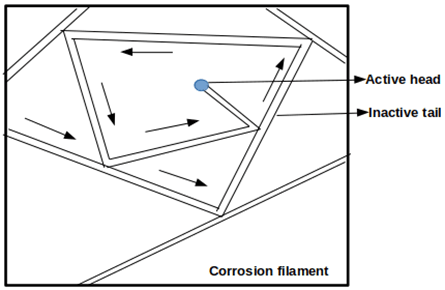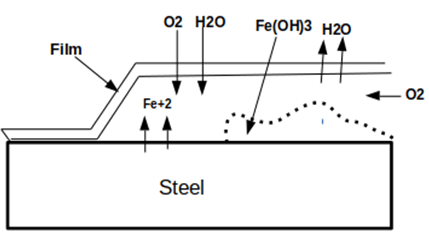This set of Corrosion Engineering Multiple Choice Questions & Answers (MCQs) focuses on “Eight Forms – Filiform Corrosion”.
1. Which of the following characteristics of active-passive metal will acquire optimize crevice corrosion resistance?
a) A narrow active-passive transition
b) A small critical current density
c) An extended passive region
d) A narrow active-passive transition, a small critical current density, and an extended passive region
View Answer
Explanation: The optimum crevice corrosion resistance of active-passive transition metal is acquired by having the following characteristics: i. A narrow active-passive transition
ii. A small critical current density
iii. An extended passive region
2. Which of the following corrosion testing describe the test for crevice corrosion?
a) Occluded cell corrosion
b) Galvanic effect
c) Atmospheric exposure testing
d) Kesternich chamber testing
View Answer
Explanation: Occluded cell corrosion is a corrosion testing that describes crevice corrosion. In this test, a narrow gap is maintained between two metal in a stagnant corrosive solution. An occluded cell is also known as crevice corrosion.
3. The incubation period is the amount of time required to initiate crevice corrosion on a corrosive site.
a) True
b) False
View Answer
Explanation: The incubation period is the time required to initiate the crevice corrosion on a corrosive site. It depends on many factors such as
i. Type of crevice formed
ii. Nature of material used
iii. Temperature
iv. The difference in the concentration of oxygen in the crevice and its surroundings
4. The crevice corrosion index is an index is to assist the selection of materials for construction.
a) True
b) False
View Answer
Explanation: Crevice corrosion index (CCI) is developed by Streicher. CCI is an index used to assist the selection of materials for construction. It minimizes the chances of crevice formation by proper material selection.
5. Which of the following are the methods and procedures to minimize crevice corrosion?
a) Use of welded joints instead of riveted joints
b) Avoid sharp edges and stagnant areas
c) Removal of deposits frequently
d) Use of welded joints instead of riveted joints, avoid sharp edges and stagnant areas and removal of deposits frequently
View Answer
Explanation: Combating or minimizing crevice corrosion can be done as follows:
l. Use of welded joints instead of riveted or bolted joints
ll. Avoid sharp edges and stagnant areas
lll. Regular inspection
lV. Removal of deposits frequently
V. Use of non-absorbent gaskets
6. Which of the following is a non-absorbent gasket?
a) Polyethylene
b) Isoprene
c) Teflon
d) Polyethylene and isoprene
View Answer
Explanation: Teflon (CF2=CF2) is a non-absorbent gasket. It is used in the industrial application to minimize the crevice corrosion. Whereas polyethylene and isoprene (rubber) is absorbent to fluids such as water and acids.
7. Which of the following is also known as under film corrosion?
a) Crevice corrosion
b) Filiform corrosion
c) Galvanic corrosion
d) Pitting corrosion
View Answer
Explanation: Filiform corrosion is a special type of crevice corrosion. It is also known as under film corrosion as it occurred under protective coatings or films. It usually seen on food and beverage cans.
8. Which of the following is/are the effects of filiform corrosion?
a) Weakens the metal
b) Decreases tensile strength
c) Affects surface appearance
d) Weakens the metal, decreases tensile strength and affects the surface appearance
View Answer
Explanation: This filiform corrosion affects only surface appearance on metal-coated food and beverage cans that are exposed to the high humid atmosphere. It doesn’t weaken the metal as well as decreases the tensile strength.
9. Which of the following industry has major concern on filiform corrosion?
a) Petroleum industry
b) Canning industry
c) Automobile industry
d) Petroleum and automobile industry
View Answer
Explanation: The Canning industry has a major concern on filiform corrosion. As canning is a preservation method by sealing the container’s airtightly and applying epoxy coating on the metal surface. Whereas the petroleum and automobile industry face uniform and galvanic corrosion as a major concern.
10. Which of the following ion/ions that result in the blue-green color of the active head in a corrosion filament?
a) Ferrous ions
b) Ferric oxide ions
c) Hydrated ferric oxide ions
d) Ferric oxide and hydrated ferric oxide ions
View Answer
Explanation: A under film corrosion filament consists of an active head and inactive tail. The active head contains ferrous ions, that have a characteristic color of blue-green. Whereas inactive tail contains ferric oxide and hydrated ferric oxide ions, that has a characteristic color of red-brown.
11. Which of the following type of corrosion filament interaction is depicted in the given figure?

a) Reflection of corrosion filament
b) Splitting of corrosion filament
c) Joining of corrosion filament
d) Death trap of corrosion filament
View Answer
Explanation: Since the growing filaments can’t cross inactive tails, they frequently get trapped and dies as the available space is decreased. This is known as the death trap.
12. Which of the following is the most environmental factor of filiform corrosion?
a) Relative humidity of the atmosphere
b) Temperature
c) pH of the environment
d) Temperature and pH of the environment
View Answer
Explanation: Relative humidity of the surroundings is the most environmental factor of filiform corrosion. It occurs primarily between 65% to 90% relative humidity. If the relative humidity is less than 65%, the metal is unaffected.
13. What are the preventions of filiform corrosion?
a) Use of coatings with low water permeability
b) To store in low-humidity environment
c) To store in high-humidity environment
d) Use of coatings with low water permeability and to store in a low-humidity environment
View Answer
Explanation: Filiform corrosion is a special type of crevice corrosion, occurs under metal coatings in a relatively high-humidity environment
Preventions to filiform corrosion:
i. Use of coatings with low water permeability
ii. To store in a low-humidity environment
iii. Use of brittle films or coatings
14. Which of the following type of corrosion is depicted in the given figure?

a) Crevice corrosion
b) Galvanic corrosion
c) Filiform corrosion
d) Uniform corrosion
View Answer
Explanation: Here, the figure depicts the corrosion of steel under film or coating. This corrosion is called filiform corrosion and it is caused due to the relative humidity of the atmosphere.
Sanfoundry Global Education & Learning Series – Corrosion Engineering.
To practice all areas of Corrosion Engineering, here is complete set of 1000+ Multiple Choice Questions and Answers.
If you find a mistake in question / option / answer, kindly take a screenshot and email to [email protected]
- Check Metallurgical Engineering Books
- Apply for Metallurgical Engineering Internship
- Practice Metallurgical Engineering MCQs
- Practice Mechanical Engineering MCQs
- Check Mechanical Engineering Books
